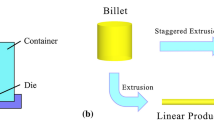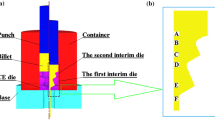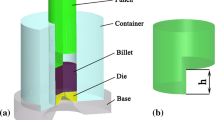Abstract
There are some bottlenecks in the traditional lightweight curved forming manufacturing, such as long process flow, high cost, low efficiency, and large energy consumption. This is undoubtedly contrary to the development concept of green forming manufacturing, and the staggered extrusion rule is one of the effective ways to solve this problem. In this paper, the distribution characteristics of flow velocity on the cross section of extrusion die and its mapping relationship with the curvature change of curved material are analyzed by finite element simulation. The effects of different staggered distance h values on grain morphology, recrystallization behavior, and texture of AZ31 magnesium alloy extruded by staggered extrusion were studied by metallographic microscope and electron backscatter technology. The results show that the staggered extrusion method can promote the deep refinement of grain size of extruded products. When h = 16 mm, the average grain size is only 1/10 of the original billet, reaching 11.40 μm. At the same time, the recrystallization behavior is more fully, reaching 87.02%, and the texture strength is as low as 9.74, indicating that DRX is one of the main reasons for weakening texture. It provides scientific guidance and technical support for the formulation and industrial application of the magnesium alloy curved material staggered extrusion process scheme.









Similar content being viewed by others
Data availability
The data obtained in the framework of this study are available to the journal upon request.
References
Kummar V, Dixit US (2020) Estimation of temperature-dependent yield strength and modulus of elasticity during laser bending. Measurement 154:107515
Ma J, Welo T, Wan D (2021) The impact of thermo-mechanical processing routes on product quality in integrated aluminium tube bending process. J Manuf Process 67:503–512
Li C, Guan Y, Wang X et al (2018) Experimental and numerical studies on heat transfer characteristics of vertical deep-buried U-bend pipe to supply heat in buildings with geothermal energy. Energy 142(jan.1):689–701
Müller KB (2006) Bending of extruded profiles during extrusion process. Int J Mach Tools Manuf 46(11):1238–1242
Shiraishi M, Nikawa M, Goto Y (2003) An investigation of the curvature of bars and tubes extruded through inclined dies. Int J Mach Tools Manuf 43(15):1571–1578
Zhou WB, Lin JG, Trevor AD et al (2017) A novel application of sideways extrusion to produce curved aluminium profiles: feasibility study. Procedia Eng 207:2304–2309
Min F, Liu H, Zhu G et al (2021) Self-bending extrusion molding of distorted channels. J Mech Sci Technol 35(5):1945–1953
Wang YP, Li F, Shi WY et al (2019) Dynamic recrystallization and metal flow behavior of AZ31 magnesium alloy bending products processed by staggered extrusion. J Mater Eng Perform 28(6):3551–3559
Wang YP, Li F, Li XW (2020) Effect of extrusion ratio (λ) on dynamic recrystallization of AZ31 magnesium alloy bending products prepared by staggered extrusion (SE). Int J Adv Manuf Technol 108(1–2):289–297
Zhang XJ, Li F, Wang Y, Li C, Xiao XM (2021) Recrystallization behavior and texture evolution of magnesium alloy bending products under staggered extrusion. J Mater Eng Perform 30(11):8108–8116
Zhang XJ, Li F, Wang Y, Chen ZY (2022) An analysis for magnesium alloy curvature products formed by staggered extrusion (SE) based on the upper bound method. Int J Adv Manuf Technol 119(1–2):03–313
Zhu SQ, Ringer SP (2017) On the role of twinning and stacking faults on the crystal plasticity and grain refinement in magnesium alloys. Acta Mater 144:365–375
Yang Z, Guo Y, Li J et al (2008) Plastic deformation and dynamic recrystallization behaviors of Mg-5Gd-4Y-0.5Zn-0.5Zr alloy. Mater Sci Eng A 485(1–2):487–491
Del Valle J, Perez-Prado MT, Ruano OA (2003) Texture evolution during large-strain hot rolling of the Mg AZ61 alloy. Mater Sci Eng A 355(1–2):68–78
Asqardoust S, Hanzaki AZ, Abedi H et al (2017) Enhancing the strength and ductility in accumulative back extruded WE43 magnesium alloy through achieving bimodal grain size distribution and texture weakening. Mater Sci Eng A 698:218–229
Del Valle J, Ruano OA (2008) Influence of texture on dynamic recrystallization and deformation mechanisms in rolled or ECAPed AZ31 magnesium alloy. Mater Sci Eng A 487(1–2):473–480
Fatemi-Varzaneh SM, Zarei-Hanzaki A, Izadi S (2011) Shear deformation and grain refinement during accumulative back extrusion of AZ31 magnesium alloy. J Mater Sci 46(6):1937–1944
Wang Y, Li F, Wang Y et al (2021) Role of grain refinement mechanism on microstructure and performance in AZ31B alloy during interactive alternating forward extrusion (AFE) process. Met Mater Int 28(4):823–832
Segal VM (2002) Severe plastic deformation: simple shear versus pure shear. Mater Sci Eng A 338(1–2):331–344
Roberts W, Ahlblom B (1978) A nucleation criterion for dynamic recrystallization during hot working. Acta Metall 26(5):801–813
Chen SF, Song HW, Zhang SH et al (2019) Effect of shear deformation on plasticity, recrystallization mechanism and texture evolution of Mg-3Al-1Zn alloy sheet: experiment and coupled finite element-VPSC simulation. J Alloy Compd 805:138–152
Funding
This project is supported by the National Natural Science Foundation of China (No. 51975166).
Author information
Authors and Affiliations
Corresponding authors
Ethics declarations
Ethical approval
Not applicable.
Consent to participate
Not applicable.
Consent for publication
Not applicable.
Competing interests
The authors declare no competing interests.
Additional information
Publisher's note
Springer Nature remains neutral with regard to jurisdictional claims in published maps and institutional affiliations.
A hot research direction in plastic processing of extrusion curved profiles. The staggered extrusion proposed in this paper provides a new idea for the production of curved profiles.
Rights and permissions
Springer Nature or its licensor (e.g. a society or other partner) holds exclusive rights to this article under a publishing agreement with the author(s) or other rightsholder(s); author self-archiving of the accepted manuscript version of this article is solely governed by the terms of such publishing agreement and applicable law.
About this article
Cite this article
Chen, Z.Y., Li, F., Da Huo, P. et al. Influence mechanism of staggered distance on grain morphology evolution and texture state of AZ31 curved profile formed by staggered extrusion (SE). Int J Adv Manuf Technol 124, 197–207 (2023). https://doi.org/10.1007/s00170-022-10467-x
Received:
Accepted:
Published:
Issue Date:
DOI: https://doi.org/10.1007/s00170-022-10467-x




